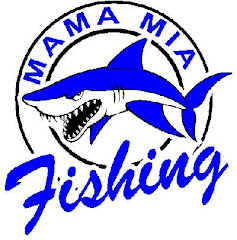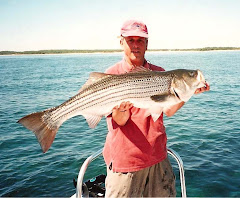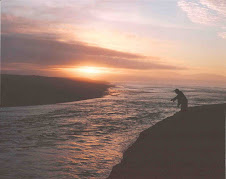
The hint of near fifty-degree temperatures that teased us all a couple weeks ago got me into a very optimistic frame of mind about the coming fishing season. I did some pre-season beach scouting and once again began to tinker with gear that lay dormant as if in some form of tackle hibernation. I took hold of all my favorite rods and one by one gave them each a very familiar flex-test, making certain they would serve me well for another season. It felt reassuring to take hold of the graphite and fiberglass wands once again. And one by one I spun the handles of my most loyal fly, spinning and bait casting reels, simply to hear the sound of the spools revolving, and to feel the mechanism’s dependable smoothness. For the reels with line still on them I gave a quick test of the drags, just to make sure they too were smooth as silk and that there would be no binding or hesitation as this year’s future trophies would try their best to terminate the tenuous connection between angler and fish. I won’t go so far as to say I caressed the tackle, but I have a favorite fishing tee shirt that reads, “My rod and reel give me comfort.” Truer words were never spoken.
I pulled out my collection of fly wallets to take inventory of favorite patterns, those I have in adequate supply and those whose stocks I still need to replenish at the tying bench. Among the flies were a number of battle tested warriors, hackles sprung loose and thread undone from sandpaper-like mouth of one too many striped bass. And there were a few flies that had seen better days before the tooth-filled maws of bluefish clamped down on them and shredded them to bits. What a way to go! One of the smaller rain bait patterns instantly brought me back to the fall run at Montauk fishing with my buddy, Captain Adrian Mason, and all the bass, blues and albies that fly fooled into thinking it was something real and alive. In do time, I will return once again to that space with fresh flies, a renewed spirit and a new batch of fish to fool. I placed all those worn flies in a pile and contemplated for a moment tossing them in the garbage can but instead dropped them in a “retirement” container along with other flies that once before also enjoyed active duty. You never know when they might provide inspiration. At minimum, they deserve to live out their remaining years with others of similar persuasion. I can only imagine the stories they will tell.
I descended next into the basement where I keep my supply of plugs, lures and all other forms of terminal gear. I needed to make sure they too were ready to serve. My boat tackle bag was the first to receive my attention. The plug boxes were in pretty neat order since my first post-season maintenance routine usually begins with me straightening out my entangled plugs mess. But one box that contains many fall favorites had escaped my due diligence. It was plug chaos at best. I sometimes fantasize that those intermingled lure bodies and hooks might just be a sign of a plug mating ritual that will result in a spawn of new year-class swimmers for me to use without having to shell out more money. But that never seems to happen. The plugs just remain intertwined in some form of spiritual bliss until I come along and ruin their fun. What struck me was that a few of my favorites seemed in perilously short supply, a direct result of my inclination not to use wire leaders when monster bluefish maraud late season baitfish. I make a mental note to use higher pound-test fluorocarbon next season. A few of my favorite bonito and false albacore plugs are in really bad shape, perhaps even beyond hope. They are actually small, modified freshwater plugs and the pelagics just beat them up mercilessly. I will attempt some plug surgery to restore some dignity so they might enjoy at least one more season with me. I hate getting rid of old plugs so I work hard at restoration. That’s the least I would want someone to do for me! Prop me up, fix me up, stick me in a pair of waders, hand me a rod and give me one more season. I hope that goes on forever! Don’t we all?
Living ones allotted time around fishing seasons is much more than a life style choice; it is a way of living ones life. And part of that process is the anticipation that comes with the arrival of a new fishing year. Sometimes, it’s the best part.
I pulled out my collection of fly wallets to take inventory of favorite patterns, those I have in adequate supply and those whose stocks I still need to replenish at the tying bench. Among the flies were a number of battle tested warriors, hackles sprung loose and thread undone from sandpaper-like mouth of one too many striped bass. And there were a few flies that had seen better days before the tooth-filled maws of bluefish clamped down on them and shredded them to bits. What a way to go! One of the smaller rain bait patterns instantly brought me back to the fall run at Montauk fishing with my buddy, Captain Adrian Mason, and all the bass, blues and albies that fly fooled into thinking it was something real and alive. In do time, I will return once again to that space with fresh flies, a renewed spirit and a new batch of fish to fool. I placed all those worn flies in a pile and contemplated for a moment tossing them in the garbage can but instead dropped them in a “retirement” container along with other flies that once before also enjoyed active duty. You never know when they might provide inspiration. At minimum, they deserve to live out their remaining years with others of similar persuasion. I can only imagine the stories they will tell.
I descended next into the basement where I keep my supply of plugs, lures and all other forms of terminal gear. I needed to make sure they too were ready to serve. My boat tackle bag was the first to receive my attention. The plug boxes were in pretty neat order since my first post-season maintenance routine usually begins with me straightening out my entangled plugs mess. But one box that contains many fall favorites had escaped my due diligence. It was plug chaos at best. I sometimes fantasize that those intermingled lure bodies and hooks might just be a sign of a plug mating ritual that will result in a spawn of new year-class swimmers for me to use without having to shell out more money. But that never seems to happen. The plugs just remain intertwined in some form of spiritual bliss until I come along and ruin their fun. What struck me was that a few of my favorites seemed in perilously short supply, a direct result of my inclination not to use wire leaders when monster bluefish maraud late season baitfish. I make a mental note to use higher pound-test fluorocarbon next season. A few of my favorite bonito and false albacore plugs are in really bad shape, perhaps even beyond hope. They are actually small, modified freshwater plugs and the pelagics just beat them up mercilessly. I will attempt some plug surgery to restore some dignity so they might enjoy at least one more season with me. I hate getting rid of old plugs so I work hard at restoration. That’s the least I would want someone to do for me! Prop me up, fix me up, stick me in a pair of waders, hand me a rod and give me one more season. I hope that goes on forever! Don’t we all?
Living ones allotted time around fishing seasons is much more than a life style choice; it is a way of living ones life. And part of that process is the anticipation that comes with the arrival of a new fishing year. Sometimes, it’s the best part.










